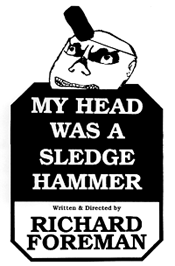
Perhaps the problem with online identity is with the word itself. The word carries a big payload, Freud might say it’s overdetermined, in the same way as a dream image. And as we chase online identity, we go charging down corridors to find a hall of mirrors.
The theater and writing of Richard Foreman forced its way into the conversation as I tried to deepen the question. Especially his play “My Head was a Sledgehammer,” and this bit of dialogue:
In a certain play entitled “My Head Was a Sledgehammer,” a certain character falls deeply in love with his mirror image, although his mirror image doesn’t resemble him in many important ways. But is a much more beautiful image…
Human-Computer Interaction (HCI) is the intersection of a world filled with ambiguity and a world purged of ambiguity. Encoding identity and attempting to make all its attributes visible, discrete and parsable is a form of extreme technological optimism with a hidden set of metaphysical assumptions.
Ben Brantley, in his review of Foreman’s play says:
Ultimately, there are no concrete answers in this endlessly mutating universe. Mr. Foreman, as always, seems far more interested in journeys than in destinations, in the intransitive rather than the transitive. And if “Sledgehammer” has a moral, it seems to be that to try to reduce life to a formula is to deny its confounding multiplicity.
When we wade out from the shallow waters we promptly get out of our depth. When we think of online identity perhaps we need something simpler. I’m me, and my online identity is a sledgehammer I use for certain tasks.
Comments closed